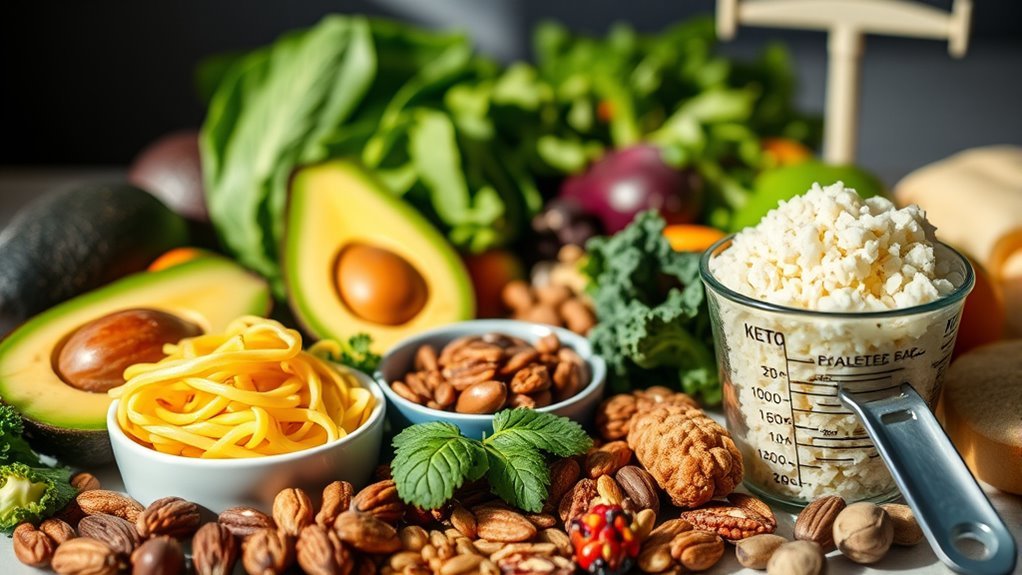On a ketogenic diet, you should target a daily carbohydrate intake of 20 to 50 grams. This significant reduction helps your body shift from burning glucose to burning fat for energy. It’s crucial to focus on whole foods like leafy greens and low-carb vegetables to stay within your carb limits. Tracking your intake can help you avoid common pitfalls. If you want to learn more about maintaining ketosis and optimizing your diet, there are plenty of strategies to explore.
Understanding Ketosis and Carbohydrate Intake

When you’re aiming to enter ketosis, understanding your carbohydrate intake is essential, as it directly influences your body’s ability to burn fat for fuel instead of glucose. The ketosis process requires a significant reduction in carbs, typically to around 20-50 grams per day, depending on individual factors. This low-carb approach encourages your body to shift its energy source, providing keto benefits like improved mental clarity, increased energy, and weight loss. By limiting carbs, you facilitate the production of ketones, which serve as an alternative energy source. Embracing this dietary shift can offer you greater freedom in achieving your health goals, allowing your body to thrive on fat rather than being dependent on carbohydrates for energy.
General Guidelines for Carb Consumption

To effectively maintain ketosis, it’s important to follow some general guidelines for carbohydrate consumption. Aim for a daily intake of about 20 to 50 grams of net carbs, focusing on whole foods like leafy greens and low-carb vegetables. Incorporate keto meal planning to guarantee you’re choosing nutrient-dense options while keeping carbs low. If you’re looking for flexibility, consider carb cycling, which involves alternating between low and higher carb days to boost metabolism without kicking you out of ketosis. This approach can help you enjoy a wider variety of foods while still adhering to your keto goals. Remember, consistency is key, so track your intake to stay within your desired carb range.
Calculating Your Individual Carb Needs

Determining your individual carb needs on a keto diet is vital for successfully maintaining ketosis. To achieve this, you’ll want to engage in personalized carb calculations that take into account your unique metabolic factors. Factors like age, gender, activity level, and overall health can greatly influence how many carbs you can consume while remaining in ketosis. Generally, starting with a target of 20-50 grams of net carbs per day is recommended, but adjusting this based on your body’s responses is important. As you monitor your ketone levels and energy, you can fine-tune your carb intake. This tailored approach empowers you to take control of your health while enjoying the benefits of a keto lifestyle.
Types of Carbohydrates: Net vs. Total
Understanding the difference between net and total carbohydrates is key to effectively managing your carb intake on a keto diet. Total carbohydrates include all carb sources, while net carbohydrates subtract dietary fiber and certain sugar alcohols, as these don’t greatly impact blood sugar levels. By focusing on net carbohydrates, you can better align your macro ratios and guarantee you stay within your daily limits. Foods with low glycemic index are often keto-friendly, making them ideal for your carb cycling strategy. Monitoring carbohydrate timing can also enhance your fat-burning potential. As you explore different carbohydrate sources, remember that not all carbs are created equal, so prioritize those that fit your keto lifestyle.
The Role of Fiber in a Keto Diet
Although fiber is often overlooked in discussions about the keto diet, it plays an essential role in maintaining digestive health and overall well-being. Including fiber in your diet offers numerous benefits, such as promoting regular bowel movements and preventing constipation. You can find fiber sources in low-carb vegetables, nuts, and seeds. Soluble fiber helps to regulate blood sugar levels, while insoluble fiber aids in digestion. On a keto diet, you might consider fiber supplements to reach your daily intake, especially if you struggle to get enough from food alone. Balancing both types of fiber guarantees you enjoy their full benefits, supporting your digestive health while allowing you the freedom to thrive on your keto journey.
Tracking Your Carb Intake Effectively
Tracking your carb intake is essential for staying within your keto limits. You can use various carb counting methods and tools, like apps or food diaries, to help you monitor what you eat. Understanding these resources can make your keto journey more effective and sustainable.
Carb Counting Methods
When you start on a keto diet, knowing how to count carbs effectively is essential for staying within your daily limits. One effective method is to use carb counting, where you track the total grams of carbohydrates consumed daily. You can also focus on portion control, ensuring your servings align with your carb goals. Familiarize yourself with the carb content of various foods, especially hidden carbs in sauces or packaged items. Keeping a food diary can help maintain awareness of your intake. You might also consider categorizing foods into low-carb and high-carb groups, simplifying your choices. By mastering these methods, you can enjoy the freedom of a keto lifestyle while staying on track with your goals.
Tools for Tracking
Finding the right tools can make a significant difference in effectively tracking your carb intake on a keto diet. Consider using tracking apps that allow you to log meals and monitor your daily carb consumption. Meal planners can help you strategize your meals, ensuring you stay within your carb limits. Progress journals enable you to reflect on your journey and adjust as needed. Carb counters and food diaries provide clear insights into your intake. Nutrition databases offer valuable information on various foods, while online calculators can assist in determining your macronutrient ratios. Engaging in community forums can provide support and tips from others on similar journeys, enhancing your overall experience and helping you achieve your keto goals.
Common Mistakes to Avoid on Keto
When following a keto diet, it’s easy to underestimate your carb intake, which can derail your progress. Additionally, many people overlook hidden sugars in packaged foods that can add up quickly. Being aware of these common pitfalls can help you stay on track and achieve your keto goals.
Overestimating Carb Intake
Although many people embrace the ketogenic diet for its potential health benefits, overestimating carb intake can be a significant pitfall. You might think you’re sticking to your carb limits, but common misconceptions can lead you astray. Here are three key areas where overestimating portions often occurs:
- Snacks: Many low-carb snacks still contain hidden carbs that add up quickly.
- Condiments: Sauces and dressings can be deceptively high in sugars; always check labels.
- Vegetables: While healthy, some starchy veggies can sneak in more carbs than you realize.
Being aware of these factors will help you stay on track. Remember, understanding your carb intake is essential for achieving your keto goals and maintaining your freedom in food choices.
Ignoring Hidden Sugars
Many people focus on counting carbs from obvious sources but often overlook hidden sugars lurking in their food choices. These hidden sugars can greatly impact your keto journey, leading to unintentional carb intake that disrupts ketosis. To help you identify common culprits, here’s an impact analysis of various foods:
| Food Item | Hidden Sugars (g) | Keto-Friendly? |
|---|---|---|
| BBQ Sauce | 12 | No |
| Salad Dressings | 3-6 | Depends |
| Granola Bars | 10-15 | No |
| Flavored Yogurt | 10-20 | No |
| Low-Fat Products | 5-10 | Depends |
Tips for Enjoying Low-Carb Meals
To truly savor low-carb meals, it’s crucial to embrace a variety of ingredients that not only satisfy your cravings but also provide essential nutrients. Here are some tips to enhance your low-carb dining experience:
- Meal Prep: Preparing your meals in advance can help you resist temptation and stick to your low-carb goals. Cook large batches and store them for easy access.
- Creative Recipes: Experiment with different herbs, spices, and low-carb substitutes to make your meals exciting. Think zucchini noodles or cauliflower rice!
- Focus on Whole Foods: Prioritize vegetables, healthy fats, and quality proteins. These not only keep you full but also guarantee you’re getting the nutrients your body needs.
With these strategies, you’ll find that low-carb meals can be both enjoyable and satisfying.
Adjusting Carb Intake Based on Activity Level
When you engage in physical activity, adjusting your carb intake can considerably impact your energy levels and overall performance. Higher activity intensity requires more fuel, which is where carbs come into play. If you’re training hard or participating in endurance activities, consider increasing your carb intake slightly to support your energy needs. This temporary adjustment can optimize performance and help prevent fatigue. Conversely, on rest days or with lower intensity workouts, you might reduce carbs to align with your metabolic adaptation to a ketogenic diet. Finding the right balance is essential for maintaining energy while reaping the benefits of a low-carb lifestyle. Listen to your body, and adjust accordingly to achieve your fitness goals without compromising your freedom and well-being.


